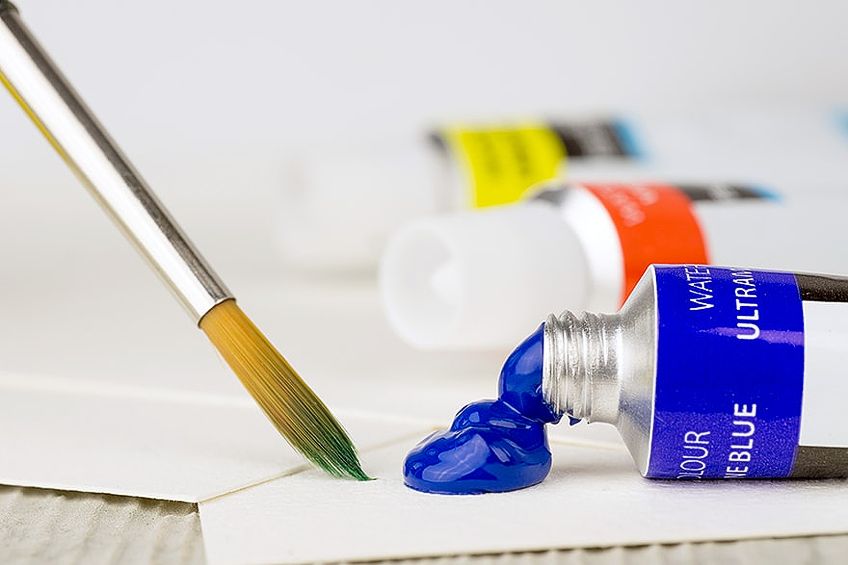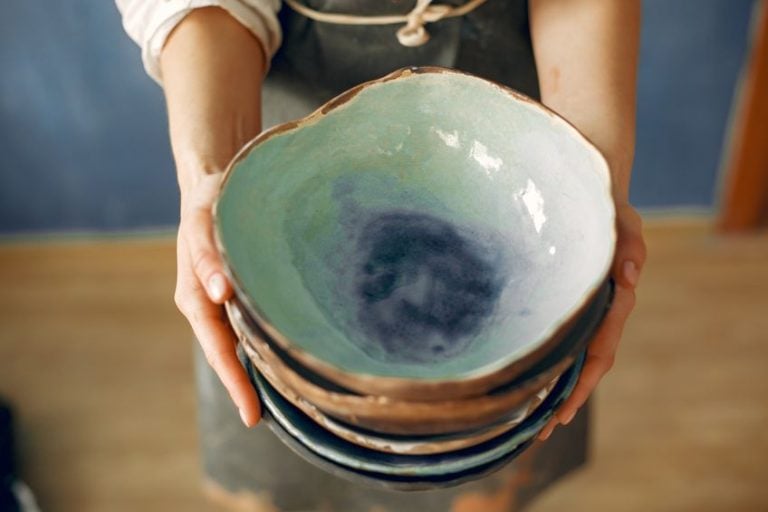Is Acrylic Paint Toxic? – A Guide on the Key Acrylic Paint Ingredients
People love to use acrylic paints to make their work look beautiful, bold, and colorful. However, they do not have any idea as to the kind of ingredients found in these acrylic paints. As a result, they become very concerned about how safe they are. In this article we will explain all there is to know about the toxicity of acrylic paints.
Toxicity of Acrylic Paints
Acrylic paints are water-based but still could contain some toxic ingredients such as cobalt, manganese, cadmium, chromium, and lead. These ingredients can cause some side effects when precautions are not followed.
You need to make sure the paint is used in a place that is well-ventilated. This is because they can become toxic when used for airbrushing, as they release some dust and fine particles. Protective gear is also recommended so that you do not breathe in the fine particles. Swallowing large amounts of paint can also cause harm. Paints that contain toxic chemicals usually have the ingredients on their label. Make sure to always check the label for ingredients every time before you purchase the paint.
Therefore, acrylic paints are generally safe to use. But it is important to use them in a well-ventilated area and consider getting protective gear to prevent any inhalation of the fine particles.
Factors to Consider When Choosing the Best Acrylic Paints
If you are planning to use acrylic paints, there are certain factors that you need to take into consideration before making your purchase. Choosing the right acrylic paint will ensure your safety as well as that of the environment.
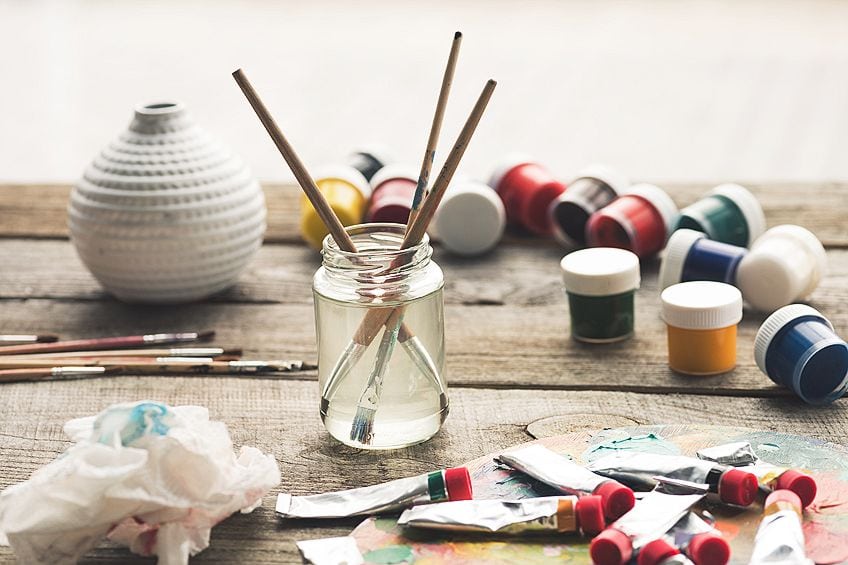
Ingredients in the Formula
Certain paints contain harmful ingredients that can be very bad for your health. For example, oil-based paints have solvents, vegetable oils, and other additives. These make them toxic for you as well as the environment. On the other hand, acrylic paints are usually not toxic.
However, when used for airbrushing they can release some toxic fine particles that are harmful for your health when inhaled. Some of the toxic ingredients in the paint include lead, cobalt, manganese, cadmium and chromium. It is always important to check the label before purchasing the paint.
Presence of Toxins
Check the safety of acrylic paints before you purchase them. Always go for acrylic paints that are labelled as non-toxic and have an ASTM warning on the label. This warning tells you that it is no-toxic and also indicates how you can use the paint to ensure your safety.
You can also visit the brand’s website for more information about the safety of the paint. Acrylic paints also contain ingredients like propylene glycol which are harmful to the environment but not to people. Therefore, you should be mindful of how you dispose of the paint.
Safety of the Workplace
Ventilation is very important when you are painting because acrylic paints can release some harmful chemicals into the air. Make sure you always work in a well-ventilated area so as to ensure that you do not inhale the harmful chemicals. You should wash your hands regularly when painting to avoid accidentally swallowing the paint.
If you are working in an enclosed place, do not sand the surface. Instead, do this when you are working outdoors. Use of protective equipment like a breathing mask is also recommended so that you do not breathe in any dust or paint. When choosing acrylic paints, avoid those that have dangerous pigments; instead, go for the ones that are safer.
Viscosity or Consistency
When choosing an acrylic paint, you need to consider its thickness or consistency. There are some acrylics that have a thin consistency whereas others have a thick consistency. The thin acrylic paints are good if you want to paint details while the thicker ones are best suited for blending and mixing colours. Choose the one that is best for your particular project.
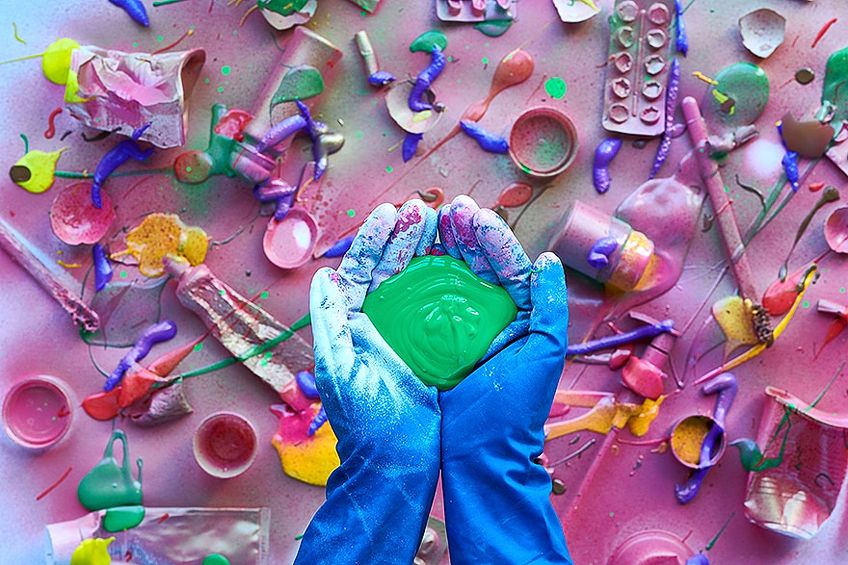
Quality
Check the quality of the acrylic paint before you purchase. They come in student’s quality and artist’s grade. The artist’s grade has a high performance and comes in many colours. On the other hand, the student’s grade comes at a cheaper price, although the performance is lower.
Drying Time
Usually, acrylics have a very short drying time, which is why most artists love to use them. However, you need to make sure that the acrylics you choose do not dry too quickly, as this can make it tricky to blend colors or paint a large area.
Advantages of Using Acrylic Paints
Most artists are now using acrylic paints for their projects. Children also love to use acrylic paints to make their artwork more colorful. Below we have listed the advantages of using acrylic paints.
[su_shadow style=”simple”][su_panel]- Acrylic paints dry faster than most paints. Some acrylic paints will completely dry within 3 to 4 hours after application.
- They have less of an odor and are non-flammable.
- Acrylic paints allow you to create colour blends easily.
- Using acrylic paint will give you a coat that is durable.
- They easily adhere to most surfaces like wood, fabric, metal, and so on.
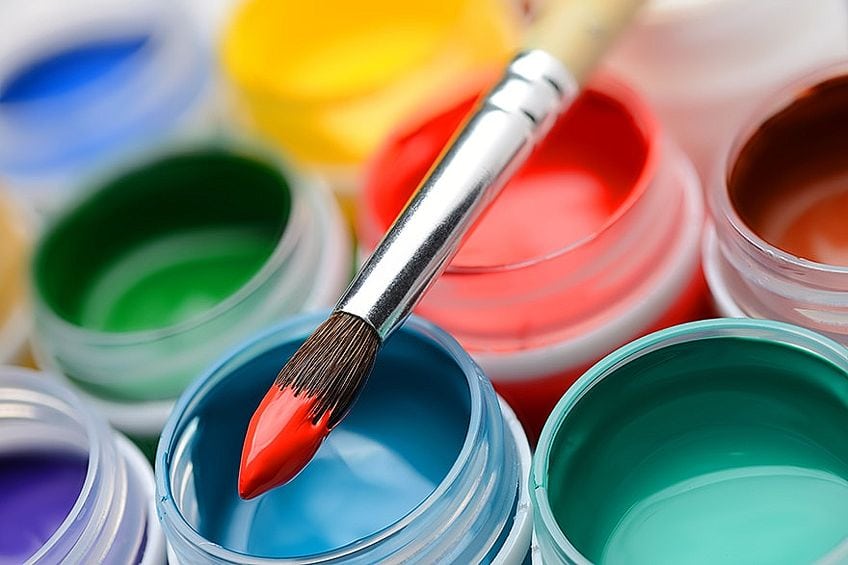
Are Acrylic Paints Safe for Children?
Painting is a very good way to keep your children occupied and happy. But how safe are these acrylic paints for your children? Acrylic paints differ in terms of their composition. The safety of these paints depends on how they are applied and the ingredients included in them. Paints that are non-toxic are safe for your children, although supervision should still be exercised when they are using them.
Some brands of acrylic paints include hazardous chemicals in their paints. Such paints should not be used by children because they are harmful. For your children’s safety, we advise looking out for harmful ingredients before you purchase any acrylic paint.
Precautions to Be Followed by Children
Although acrylic paint is non-toxic, there are certain tips that you need to follow to make sure that your children are safe. This is because children can easily stick their fingers into their mouth when painting, which can cause harm. Therefore, it is important to explain to your children the proper way to use these acrylic paints and the safety tips that they need to follow.
- Be sure to purchase acrylic paints that are non-toxic.
- You need to make your children wear nitrile gloves when painting so that toxins do not get to their skin.
- Make your children wear breathable masks.
- Wash and clean away all paints from their hands once done with the painting.
- Make sure your children are painting in a well-ventilated area.

Other Paints Safe for Children’s Use
There are so many paint alternatives that you can consider if you are not sure about the safety of acrylic paints. Below is a list of some of these paints:
- Tempera Paint: Tempera paint has a faster drying time and is very easy to clean. This paint does not crack or flake and can be used on canvas, wood, cardboard, as well as paper. It is available in both powder and liquid form, but the powder form is not safe for children since the dust particles can be harmful when inhaled.
- Finger Paint: This type of paint is best suited for young artists. Its formula makes it very easy to clean from the hands. To reduce splashing, we recommend that you choose finger paint that has a creamy formula.
- Watercolor Paint: This type of paint is very bright and comes in many colors. It requires a surface that has maximum absorption. Therefore, it should be used on a thick paper.
- Activity Paint: This paint is a great choice for a wide range of activities. It was designed with kids in mind. It has a gel-like formula and is water-based. This paint can be used on many surfaces and is easy to clean.
Before buying any paint for your children, always remember to consider how safe it is for them. Make sure to get paints that are free of toxic chemicals. They should have an AP (approved product) seal on them. This seal tells you that the product is not harmful for your children and does not contain any substances that can cause health problems. Also check if the product is approved by the American Society for Testing Materials, which you can do by finding the ASTM D-4236 code.
Toxicity of Acrylic Paint if Swallowed
When consumed in large amounts, acrylic paint can become very harmful and lead to health problems. Acrylic paints contain substances that you would not want your child to consume, which is why it is important to supervise younger children when they are using it. You also need to make them understand that their fingers should not go into their mouth when painting.
For very young children under the age of three, acrylic paint is not recommended since they have a tendency to put fingers in their mouth. Wait until they are a little older so that you can easily explain to them that paints should not go in their mouth. If your child accidentally consumes the paint, make sure that you wash their mouths thoroughly and make them drink lots of water. If the case is serious and your child consumed large amounts of paint, then contact poison control or a doctor.
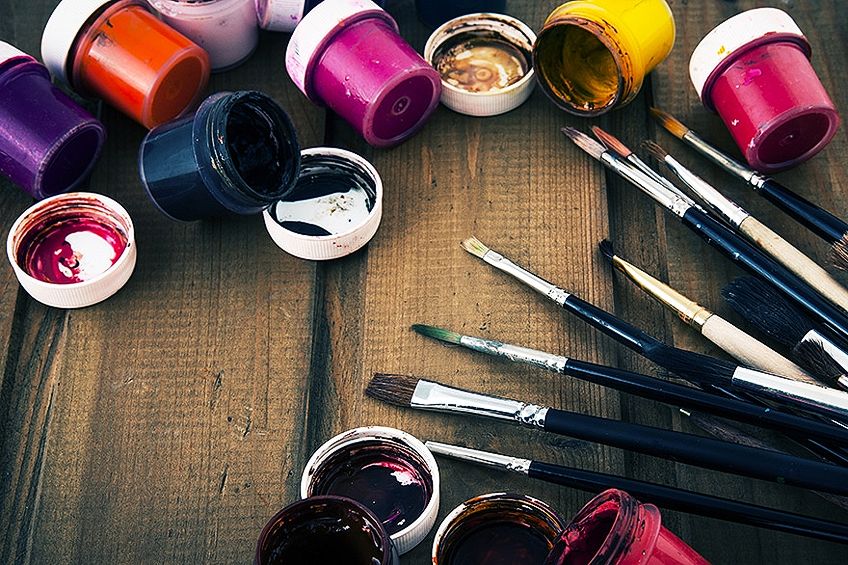
Is Acrylic Paint Harmful to Pets?
Pets can get really curious and wander to your work area, newly painted objects, and where you keep your painting supplies. Your dog or cat may end up licking or ingesting some paint. Acrylic paint is water-based, hence not toxic to your pets. When it is ingested in small amounts, it can irritate your pet’s mucous membranes as well as their skin.
If your dog or cat ingests the acrylic paint in large amounts, then serious problems like nausea and vomiting may occur. If you notice this, contact your veterinarian. If you also notice signs like tremors, diarrhea, depression, difficulty in breathing, and difficult in walking, do not hesitate to contact your veterinarian.
It is perfectly okay to use paint around your pets; you can easily make your pets participate in your art projects. However, you need to make sure that the paints you are using are non-toxic. All the materials used during the project should be properly stored and kept away.
It is important to make sure that you and your children are safe when using these acrylic paints. Always monitor your kids’ activities when using acrylic paints. Always make sure that you choose paints that do not include any hazardous ingredients in their formulation. We hope this article answered your question and helped you to learn a bit more about acrylic paints.
Frequently Asked Questions
Are Acrylic Paints Toxic?
Acrylic paints are safe to use for everyday painting. This is because they are water-based. They only get toxic when you are sanding a surface, if it is consumed in large amounts, or when the paint is used for airbrushing.
Do Acrylic Paints Contain Flammable Substances?
Acrylic paints do not include any flammable substances in their formula.
Can Acrylic Paint Cause Cancer?
Acrylic paints that are marked as non-toxic will not give you cancer. However, some acrylic paints contain harmful heavy metals like cadmium, chromium, and cobalt. These types of ingredients have been labeled as hazardous and harmful. Therefore, when buying your paint, check the label.
Are Acrylic Paints Dangerous When Consumed?
Acrylic paints can be harmful if they are ingested in large amounts. Be sure to supervise your children when they are using acrylic paints to avoid this. If they happen to swallow some of it accidentally, they should drink plenty of water, gargle with saltwater, and clean their mouths thoroughly.
Do Acrylic Paints Become Toxic When Heated?
When overheated, acrylic paint can become toxic. This is because it is a thermo-plastic and when heated at high temperatures it will emit gases that are dangerous.
Is Acrylic Paint Safe to Apply on a Child’s Face?
Acrylic paint should never be used on your child’s face. It is not suitable for use on the face because it contains pigments that cause skin irritation. Instead, use other alternative paints that are specifically created for use on the face.
Why Should I Use Acrylic Paint?
There are many reasons as to why you should use acrylic paints. Firstly, they have faster drying times than most paints, they have a longer mixing time, and create a coat that is durable.
In 2005, Charlene completed her Wellness Diplomas in Therapeutic Aromatherapy and Reflexology from the International School of Reflexology and Meridian Therapy. She worked for a company offering corporate wellness programs for a couple of years, before opening up her own therapy practice. It was in 2015 that a friend, who was a digital marketer, asked her to join her company as a content creator, and this is where she found her excitement for writing.
Since joining the content writing world, she has gained a lot of experience over the years writing on a diverse selection of topics, from beauty, health, wellness, travel, and more. Due to various circumstances, she had to close her therapy practice and is now a full-time freelance writer. Being a creative person, she could not pass up the opportunity to contribute to the Art in Context team, where is was in her element, writing about a variety of art and craft topics. Contributing articles for over three years now, her knowledge in this area has grown, and she has gotten to explore her creativity and improve her research and writing skills.
Charlene Lewis has been working for artincontext.org since the relaunch in 2020. She is an experienced writer and mainly focuses on the topics of color theory, painting and drawing.
Learn more about Charlene Lewis and the Art in Context Team.
Cite this Article
Charlene, Lewis, “Is Acrylic Paint Toxic? – A Guide on the Key Acrylic Paint Ingredients.” Art in Context. January 22, 2021. URL: https://artincontext.org/is-acrylic-paint-toxic/
Lewis, C. (2021, 22 January). Is Acrylic Paint Toxic? – A Guide on the Key Acrylic Paint Ingredients. Art in Context. https://artincontext.org/is-acrylic-paint-toxic/
Lewis, Charlene. “Is Acrylic Paint Toxic? – A Guide on the Key Acrylic Paint Ingredients.” Art in Context, January 22, 2021. https://artincontext.org/is-acrylic-paint-toxic/.


